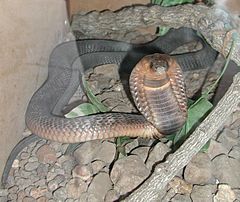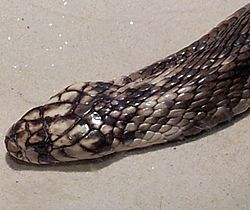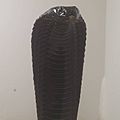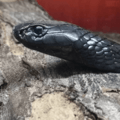Egyptian cobra facts for kids
Quick facts for kids Egyptian cobra |
|
|---|---|
 |
|
| Scientific classification | |
| Kingdom: | |
| Phylum: | |
| Class: | |
| Order: | |
| Suborder: |
Serpenta
|
| Family: | |
| Genus: | |
| Species: |
N. haje
|
| Binomial name | |
| Naja haje Linnaeus, 1758
|
|
The Egyptian cobra (Naja haje) is a type of poisonous cobra snake. People in Ancient Egypt used to worship it. This snake lives in North Africa and Southwest Asia. It is known as one of the most venomous snakes in the world.
Egyptian cobras can grow quite long, usually between 5 and 6 feet, 8 inches (1.5–2 meters). Some have even been seen as long as 8 feet! Small symbols of these cobras were part of the crown worn by the pharaohs, the rulers of Ancient Egypt.
Contents
What Does It Look Like?
The Egyptian cobra is one of the biggest cobras in Africa. Its head is large and a bit flat, and it stands out slightly from its neck. Like other cobras, it can spread the ribs in its neck to form a wide hood. This is a very recognizable feature.
The snake's snout is rounded and not too narrow. It has fairly big eyes with round pupils. The body of the Egyptian cobra is round and strong, with a long tail. How long an Egyptian cobra grows depends on where it lives and its specific type. Most are between 3 and 6.5 feet (1 to 2 meters) long. Some can reach almost 10 feet (3 meters).
Their color can change a lot. Most are some shade of brown, often with lighter or darker spots. They sometimes have a "tear-drop" mark below their eye. Some can be more copper-red or gray-brown. Cobras from northwestern Africa are almost completely black. Their belly side is usually creamy white, yellow-brown, gray, or black, often with dark spots.
Where Do They Live?

The Egyptian cobra lives across most of North Africa, especially north of the Sahara Desert. They also live in the savannas of West Africa, south of the Sahara. You can find them as far south as the Congo River area and east to Kenya and Tanzania.
In Zoos
You can also see Egyptian cobras in zoos. They are found in zoos both in their natural home and in other parts of the world. The Giza Zoo in Egypt, the San Diego Zoo in the USA, and the Virginia Aquarium all have Egyptian cobras in their reptile collections.
The Bronx Zoo Story
On March 26, 2011, the Bronx Zoo in New York City had to close its reptile house. An adolescent female Egyptian cobra had gone missing from its enclosure the day before. Zoo officials believed the cobra was still inside the building. They knew Egyptian cobras don't like open spaces. Also, the cold weather outside would have made the snake very slow.
Luckily, the cobra was found on March 31, 2011. It was in a dark corner of the reptile house and was healthy. After a contest, the cobra was named "Mia," which stood for "missing in action."
Where Do They Like to Live?
Egyptian cobras live in many different places. These include dry grasslands (steppes), savannas that can be dry or moist, and dry desert areas with some water and plants. They are often found near water.
You can also find Egyptian cobras in farm fields and areas with bushes. These snakes sometimes come into places where humans live. They are often drawn to villages because of chickens and rats, which are attracted by garbage. There have even been reports of Egyptian cobras swimming in the Mediterranean Sea, showing they enjoy water.
How Do They Behave?
The Egyptian cobra usually lives on the ground. It is most active during twilight (crepuscular) or at night (nocturnal). However, you might see it warming up in the sun early in the morning. These snakes often have a favorite spot to call home. This could be an abandoned animal burrow, a termite mound, or a rocky area.
They are active hunters and sometimes go into human homes, especially when looking for chickens. Like other cobras, they usually try to get away if someone comes near them. But if they feel threatened, they will stand up tall, spread their hood, and get ready to strike. This snake prefers to eat toads. But it will also hunt small mammals, birds, eggs, lizards, and other snakes.
About Their Venom
The venom of the Egyptian cobra mainly affects the nervous system and body tissues. When it bites, it can deliver a lot of venom. This venom stops nerve signals from reaching the muscles. Eventually, it can stop signals to the heart and lungs, which can cause death because the person can't breathe.
A bite can cause pain, swelling, bruising, and blisters where the bite happened. People might also feel a headache, sickness, stomach pain, or dizziness. They could also become weak or have seizures. Unlike some other African cobras, the Egyptian cobra does not spit its venom.
In Other Cultures
In Ancient Egypt
The Egyptian cobra was important in Ancient Egyptian mythology. It was linked to the cobra-headed goddess Meretseger. A special symbol of the Egyptian cobra, called the uraeus, represented the goddess Wadjet. This symbol was used by the Pharaohs as a sign of their power and was worn on their crowns. This tradition continued for many years.
Many old stories say that Cleopatra, a famous Egyptian queen, died from the bite of a snake called an "aspis." This "aspis" was most likely an Egyptian cobra. The stories say the snake was brought to her in a basket of figs. However, some people question these stories. This is because the venom of this snake works slowly, and the snake is large, making it hard to hide.
As a Pet
The Egyptian cobra got a lot of attention in Canada in 2006. A pet cobra got loose and caused a house in Toronto to be empty for over six months. People thought the snake was hiding inside the walls of the home.
Images for kids
See also
 In Spanish: Cobra egipcia para niños
In Spanish: Cobra egipcia para niños







